Vermeer Girl With Heart – Draw With Me!
Draw a Vermeer girl by following my formula!

This drawing is a modern version of the painting “Girl with a Pearl Earring” by Johannes Vermeer. Here, the earring is not the center of the attention, but a heart and flowers steal the show. I have made a simple formula to draw and color the girl’s face, and then you can put your own twist on the head and add whatever decorations you want there.
Supplies
You can use colored pencils, watercolor pencils, watercolors, acrylic paints, oil paints – or any medium that has a possibility to create color mixes. My example uses colored pencils. For the face, you need three browns: one dark, one middle, and one very light brown. You also need a little bit red for the lips and black for some small details. White is optional. When working on white or almost white background, you can just leave the white areas uncolored as I do in my example. I do use a little bit white to blend the red of the lips into paper white.

I created my Vermeer girl directly on an art journal page. My art journal is Dylusions Creative Journal Square. Pick a journal or a paper that works well with your supplies.
Vermeer Girl – Shape by Shape Formula
To succeed you have to trust this formula. Don’t look at the original painting, follow the picture below only. Copy the shapes as accurately as you can, and don’t think about drawing a face. The girl will appear when you have all the puzzle pieces in place!
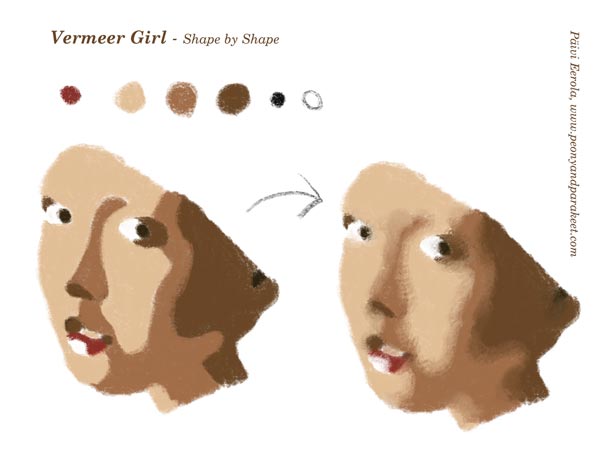
Start from the first picture and color the shapes so that they have sharp outline edges. Then blend the skin colors so that the transition from one shape to another is softer.
Starting the Drawing
If you want to put all kinds of fun stuff on the girl’s head, place the face on the left bottom corner. I marked the spot where I started the drawing with a green arrow on the photo below.
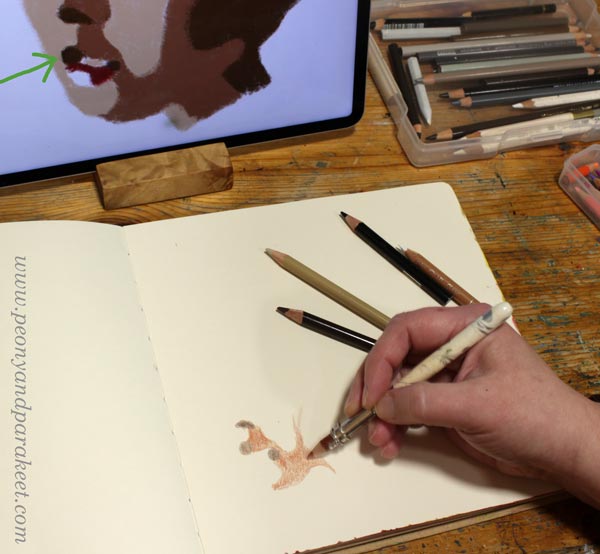
At first, the face doesn’t look like one at all. But this kind of abstraction will bring out the realistic look. Reality is always more abstract than we think.
Drawing Sharp Shapes
Human faces are very organic, so the shapes are too. Examine the curves of the formula in detail, and avoid straight lines. The more beginner you are, the more you are tempted to draw too straight, avoid that!
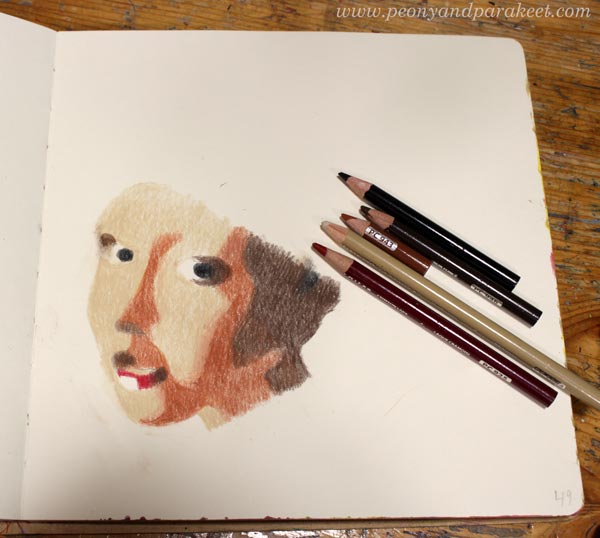
Once all the pieces are in place, the face makes sense. Take the image in front of the mirror to see if there are any distortions. If the mirror image looks wrong in some way, get back to the formula and check your shapes!

When you are satisfied with the sharp shapes, go to the second step of the formula: blending.
Vermeer Girl – Achieving the Old World Look
Old paintings have softness that our photo-oriented era doesn’t often express. We prefer sharpness over blurry. However, life is often blurry and your Vermeer Girl will look much more alive if you soften the edges of shapes, especially on the skin.

Color on the top of the shape with the neighbor color so that the shapes integrate and look less separate. Now you can also adjust the shapes a bit more freely. I lengthened the big dark brown shadow because my face became a bit longer than in the formula.
Small changes in faces can change the personality quite a lot. I think that’s fascinating! You can start from the Vermeer girl, but then end up with a character of your own.
Drawing Decorations
First, think about the size of the decorations: do you want plenty of small ones or only a few large ones. Beginners easily draw something between, but I think this portrait will look better if the decorations are either a bunch of small ones or a few large ones. I chose the latter and placed a couple of big flowers and a heart on her head.
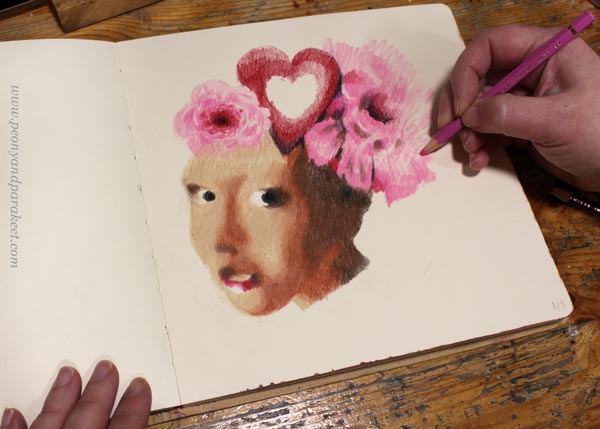
I colored the decorations freely and used no references for these. I like the contrast between the face’s carefully constructed softness and the free coloring of the flowers.
I move on to color the background just before I am finished with decorations. This way I can still change them a bit if needed. The background often gives life to the whole image and brings in more ideas for the drawing.
Starting the Background
Not only the girl’s face is composed of shapes, the background can be like that too. The only difference is that now you can freely improvise the shapes. Start with one color and sketch by coloring!
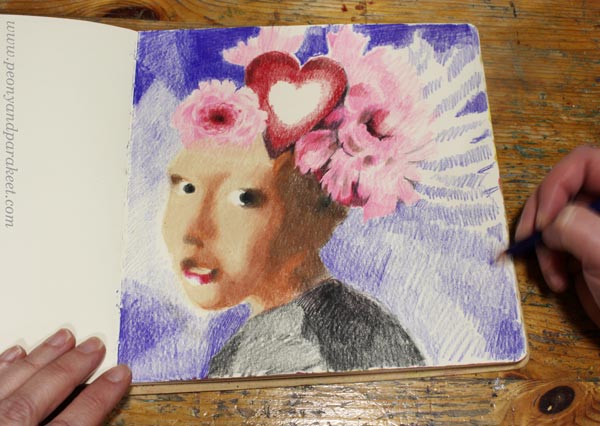
Think about the streams of air and imagine how the girl moves when she is posing in front of you.
Building the Color Scheme
To make the portrait look unified, you need to repeat the colors. My background started as blue, but in the picture below, it has started to get more brown tones. The pinks of the flowers also blend into blue. Color several layers and use a lot of blending near the edges.
I added the surrounding colors to the center of the heart like it would be a mirror. This also helps in harmonizing the atmosphere.
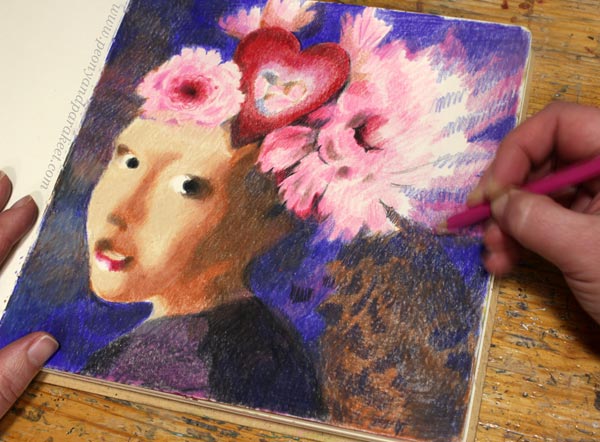
You can also play with patterns: color small shapes inside a bigger one! When located in the background, the patterns can be subtle and muted, so that they don’t steal the whole show.
Finishing the Vermeer Girl
When you are close to finishing, look at the original Vermeer painting and see how she partly disappears in the background. Especially the dark brown in the neck area can be blended with the background.

Dark background looks great with the lit face. Vermeer girl with a heart makes a wonderful Valentine’s day page in any art journal!

I hope this project made you grab your pencils and other art supplies!
Hearts and Stories – Sign up Now!
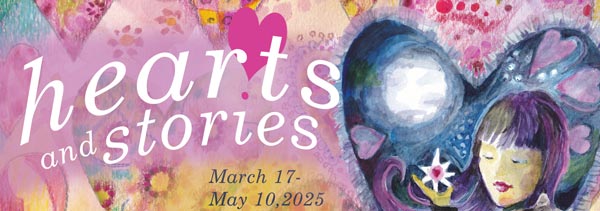
Come to play with hearts and other simple shapes! We use colored pencils, felt-tipped pens, and watercolors. Sign up for Hearts and Stories!
Flower for Your Art Journal – Step by Step Video
Let’s pick watercolors and colored pencils and make a flower for your art journal! Scroll down to watch a step-by-step video!
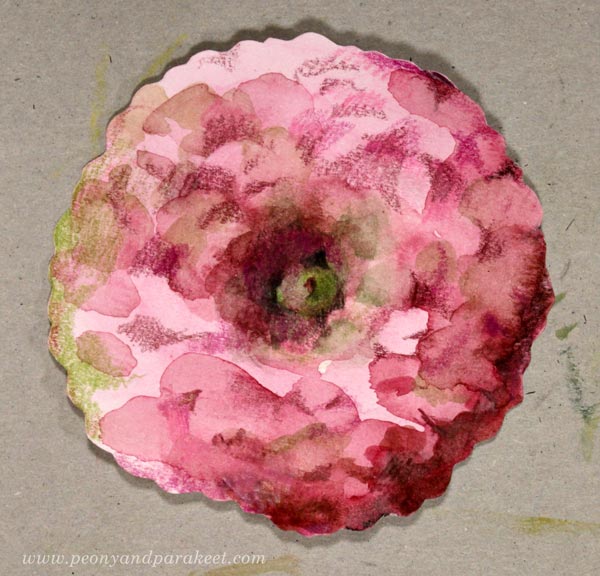
This flower can be a rose or a peony or any round and layered species. For me, it’s not so important which flower it is, but what kind of personality it expresses. Here I aimed for a soft but unapologetic character. Every flower you create will become a bit different, and soon you’ll have a collection!
Flower for Art Journal Page – Watch the Video!
The instructions for the flower and all the inspiration for using it on a page is in the video below! We’ll start with watercolors to make the foundation for the layered look and then add more sharpness with colored pencils. Some patience is required because you need to let the watercolors dry between the first steps.
In the video, I encourage you to adjust the center of the flower, the flower’s sould. Find a look and personality that appeals to you!
Including the Flower in Art Journal
In the video, I also show how you can use the flower with almost any background and make a spread for the flower in the spirit of Freely Grown.
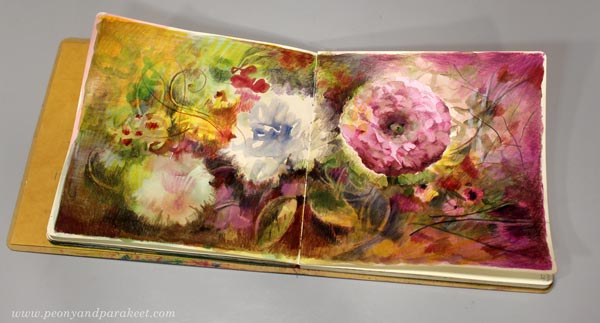
I hope this week’s video and the last week’s blog post about picture prompts inspire you to art journal and create art in general!
Torn Paper Collage for Artistic Exploration
Torn paper collage – do you remember making them as a child?
This project is not so much about the resulting image, but about the process.
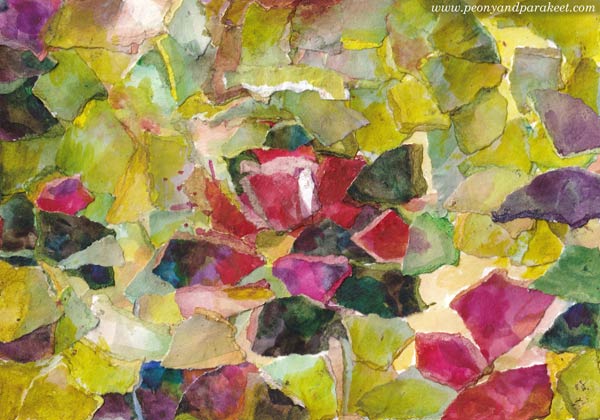
You will need watercolors, thick drawing paper, and paper glue.
I have used Fabriano Accademia Drawing Paper (200 gsm/94 lbs). It’s not as thick as most watercolor papers but holds water well and is nice for collages. I bought this paper for the course Joyful Coloring, and it has become one of my favorites because it’s so versatile.
Step 1 – Paint the Papers
One of the best ways to grow your artistic skills is to move away from ready-made images and make the material for collages yourself.
While creating, think about this!
There’s a hidden miracle in every brush stroke, even in the ugliest ones. The potential of them is huge. Your artistry grows when you keep creating.
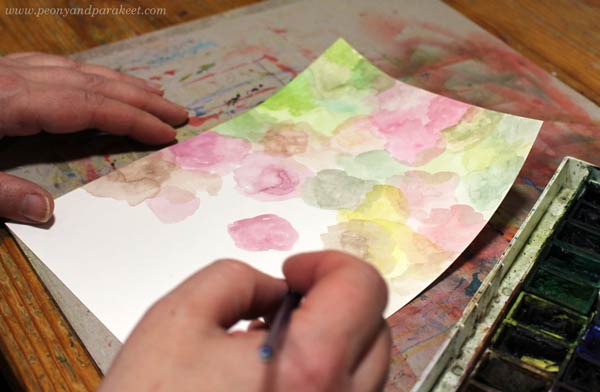
When you make the papers yourself, you can choose colors and add variation that will make every torn paper piece unique.
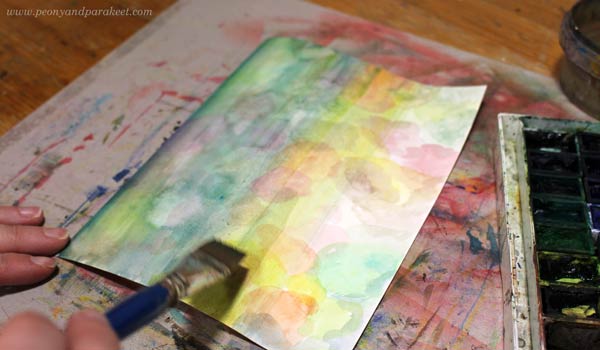
With watercolors, you easily achieve translucent effects and get great pastel tones. But also make a paper with darker and more vivid colors!
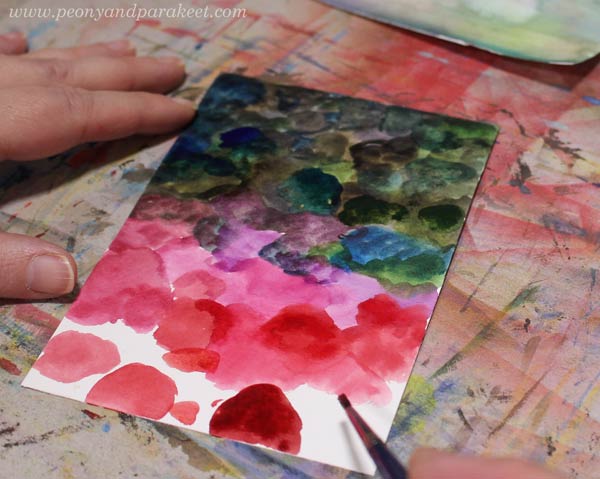
Check that you have all these variations: light, bright, and dark!
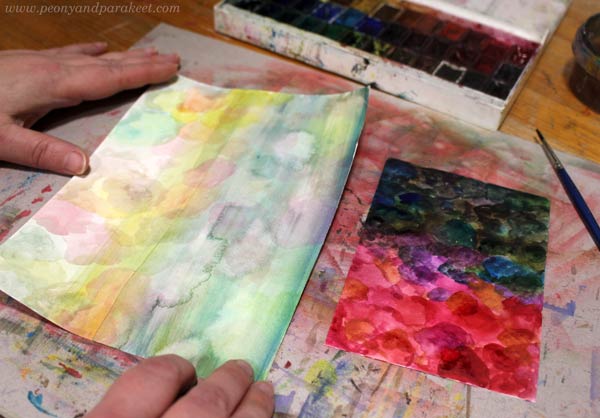
For a small collage, not so many papers are needed. My papers are 1,5 times the size of the final artwork.
Before continueing, think about this!
The papers are precious treasures. Handle them carefully like they would be glass!
Step 2 – Tore the Papers into Small Pieces
Next, let’s “break glass”! With fingers, tore the papers into pieces.
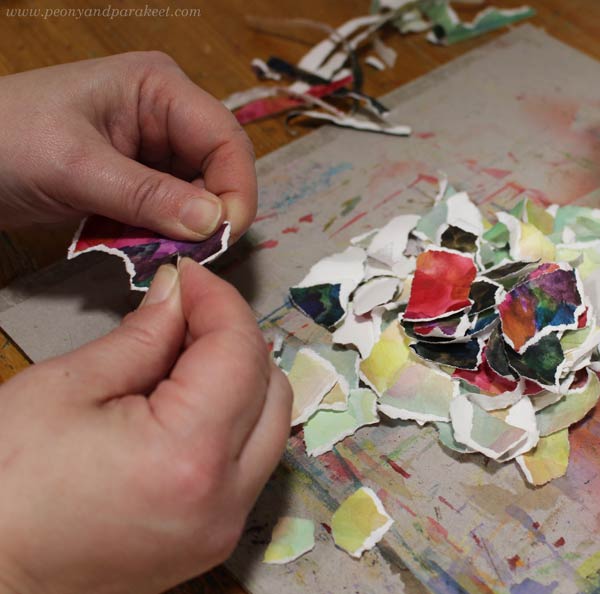
While creating, think about this!
Art is born, when you question what you see, experience, and own. While tearing the paper, let go of pre-assumptions of what you are going to create.
Step 3 – Paint the Torn Edges
The edges are the best part of torn paper collages, but especially when you paint them too. This way you don’t get too much distracting white to your collage, but the result will more colorful and atmospheric.
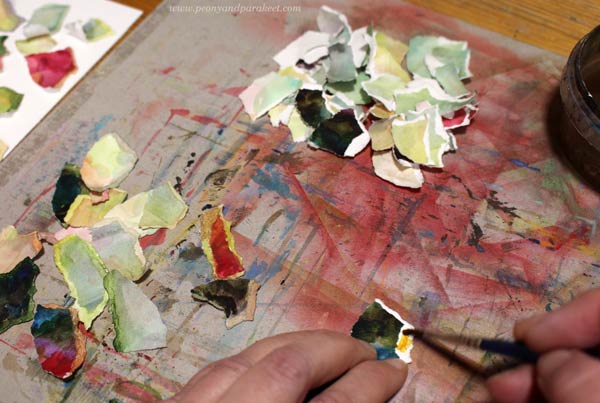
While creating, think about this!
Some people like to think a lot, some are more hands on. In artistic exploration, finding the balance is the key. This exercise is especially for thinkers. Look at the torn pieces – so many new beginnings, seeds for new ideas!
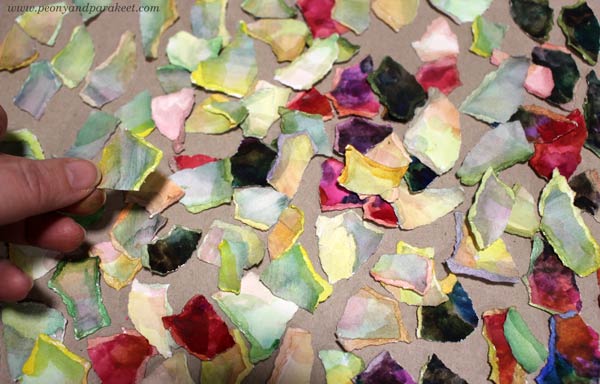
You can also spread the paint partly over the piece so that the color transition is less dramatic and the piece gets more depth. Some of my pieces have more colorful and some more blended edges. Variation is always good!
Step 4 – Glue the Pieces
Pick a blank background paper and glue the pieces on it. My background is fairly small, about 6 x 8 inches. I use Towbow Aqua Liquid Glue. It’s not perfect because it’s a bit brittle when it dries, but I like it because it doesn’t make my fingers sticky.
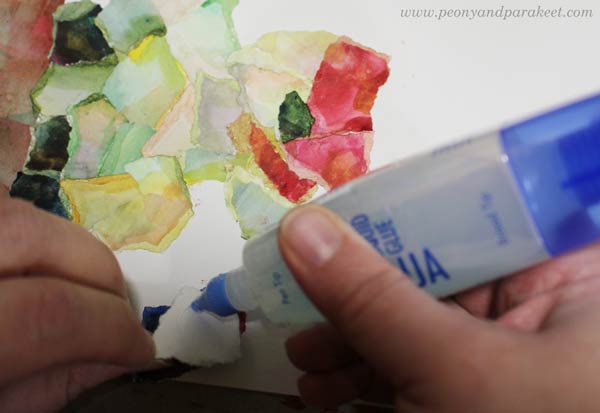
Start from one edge and work towards the center. Save most of the brights for the center and keep the edges less colorful. Create clusters and look for happy accidents.
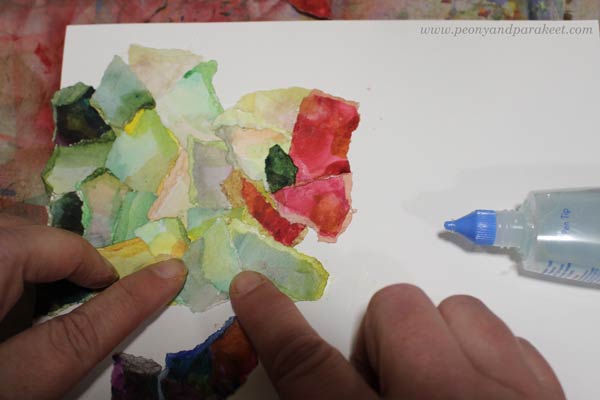
While creating, think about this!
Papers that have been destroyed now get a new beginning. It’s like a window has been shattered and a new stained glass one gives a new view. Always when you create is some kind of distortion. But that’s not a bad thing at alll. We need these new views to make a shift in our lives, to see beyond the obvious.
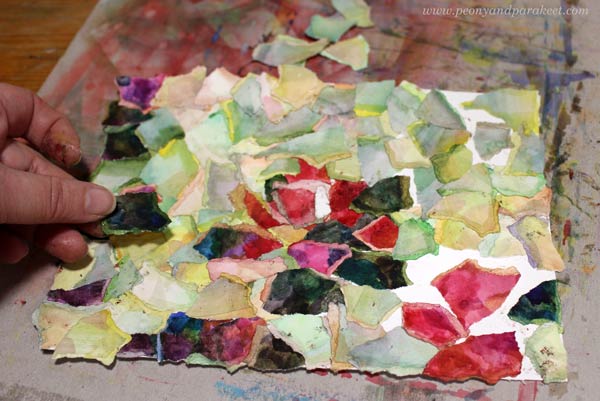
Notice, that you can leave the background partly visible here and there.
Step 5 – Finish with Watercolor
You can still adjust the collage by painting over the pieces.
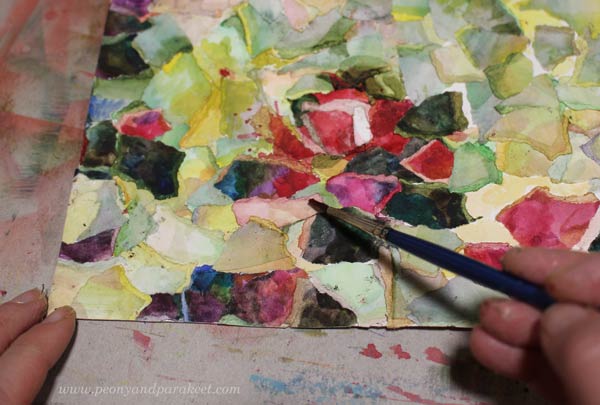
You can add details, but more than that I would recommend adding a thin color layer on most of the pieces so that you get a more unified look. I added yellow over most of the pale greens, and also to the areas where I left the blank paper visible. I like to have white as a highlight color only, and not everywhere.
While creating, do this!
Take a break! Don’t try to do everything in one sitting. Rest and give your mind some time to process what you have been doing!

The collage is now finished, but the process is not. So, proceed to the next step!
Step 6 – Explore Your Torn Paper Collage
Take photos of your torn paper collage. Don’t just take the realistic photo to your archive but get creative! Think about the light and the air and how they create a new layer to everything we see. Take the collage to a place where you get strong sunlight and dark shadows to get a new puzzle over it.
Or if you have a DSLR camera, do what I did: take the collage to a dark room, legthen the exposure so that taking the photo lasts many seconds. Then move the flashlight around the picture and its surroundings.

With the long exposure, you can also move the collage around to get an artistic photo.
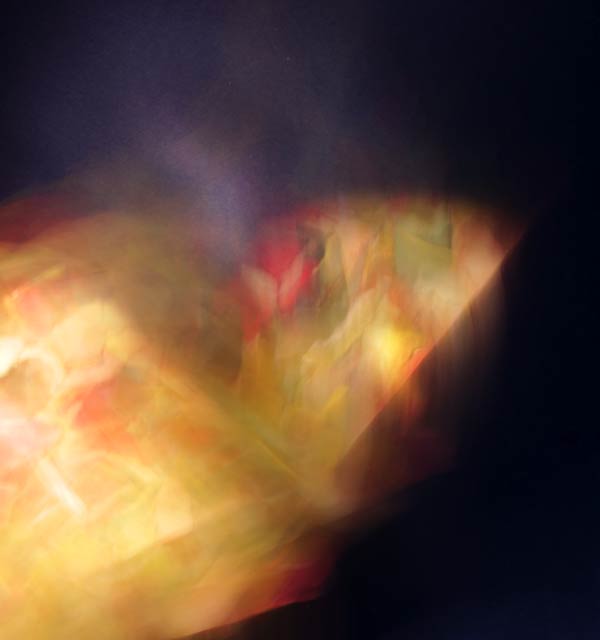
You can start with a blank paper, but end up with painting with light.
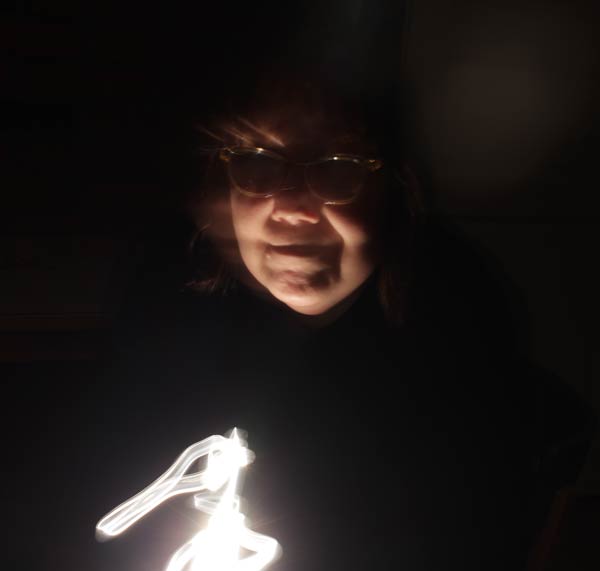
Creating art is not only about mastering techniques or imagining things. Artistic exploration is where freely practice both.
Torn Paper Collage – Where Did This Idea Come From?
The oil painting that I am currently working on, is influenced by my artistic explorations. And, it’s also vice versa. When I looked at the painting that is still in progress, I felt the need to tear some paper, and so the torn paper collage was born.
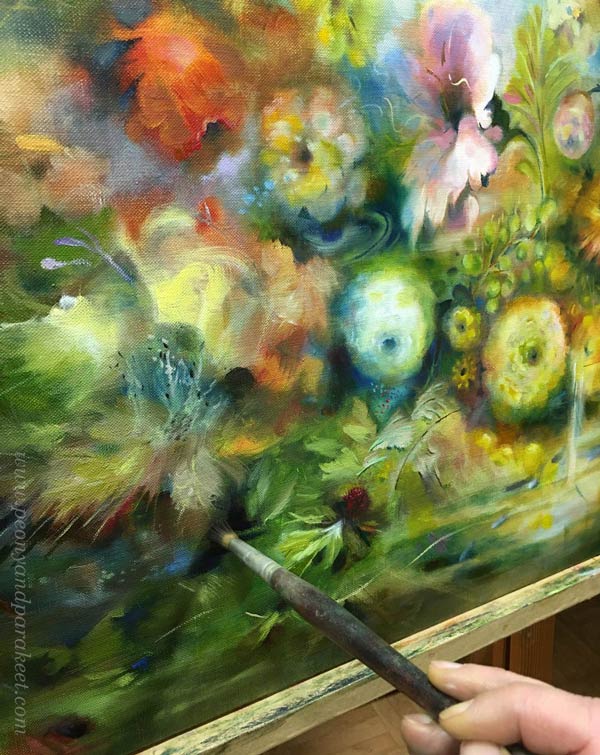
I like to explore movement, so moving the collage under the camera produced an image that is related to this painting. That photo will inspire me when I am adding finishing touches to the painting.
I believe we have to explore to move forward in the path.
What do you think?
Let’s Draw a Winter Angel
This week, we draw a winter angel step by step!
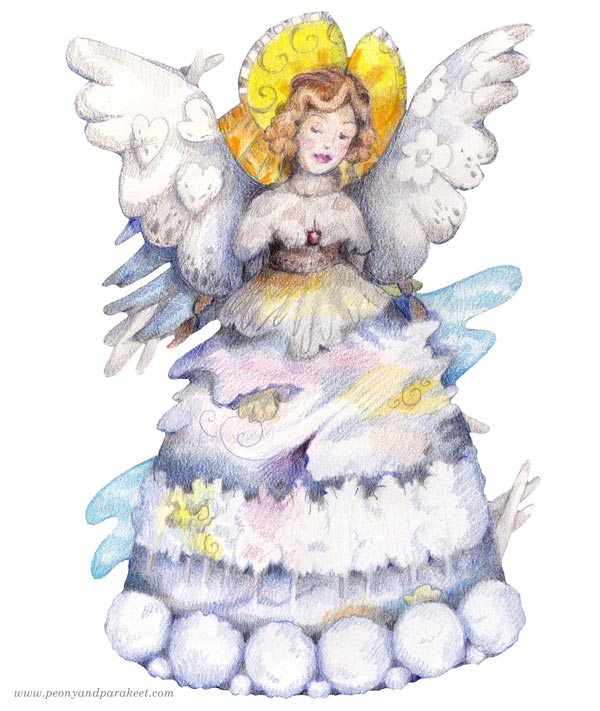
The angel begins with a simple outline sketch. The hands and feet are hidden behind the dress, so it’s easy! The skirt is big so that you can treat it as a blank canvas for winter scenery.
Step 1 – Make an Outline Sketch
Pick an A4-size or US letter-size paper and a regular pencil.
Draw a horizontal center line and then another line that divides the upper part in half.
Place a head right above the upper line and draw a simple body and a long hem.
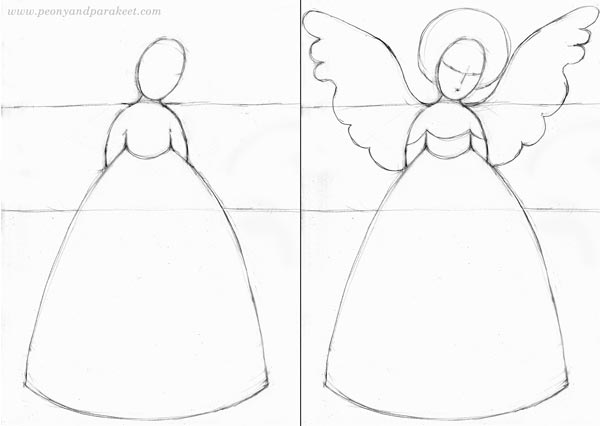
Add a circle for the halo behind the head, some marks for facial features, wings, and curves to divide the upper body into two parts.
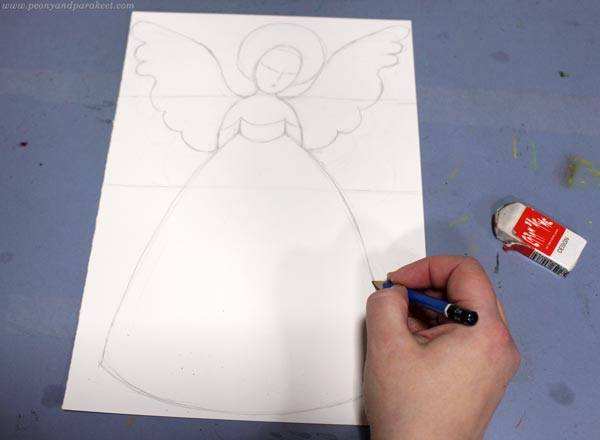
Erase the sketched lines so that you can see them only vaguely. Compare the wings in the picture above with the next picture. After erasing, the pencil sketch is visible only barely.
Step 2 – Add Foundational Ideas
Change to colored pencils. Start with the face and color lightly. Get connected with the character that you are drawing. Add some skin tone and hair. You can also draw facial features, but do it with a light hand, aiming for a connection rather than perfection at this stage.
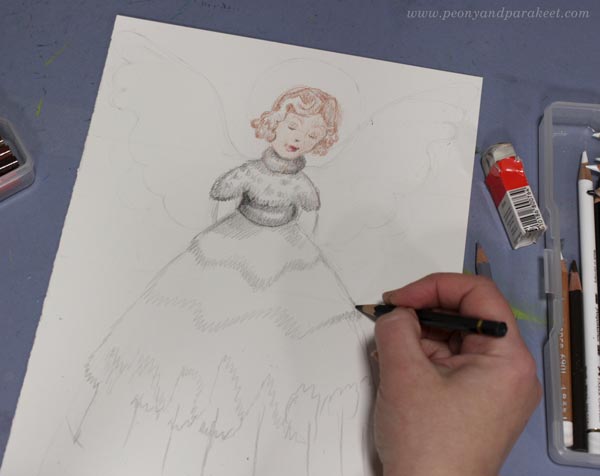
With neutral colors, add ideas for a winter feel. I draw fur on the top part of the dress and then sky and trees on the skirt.
Step 3 – Color Beyond the Outlines
Get more creative by breaking the outlines. Think about the air that rises from the cold and circulates around the dress. Imagine winds, polar lights, and layers of snow, but also immaterial things: thoughts and feelings and their liveliness.
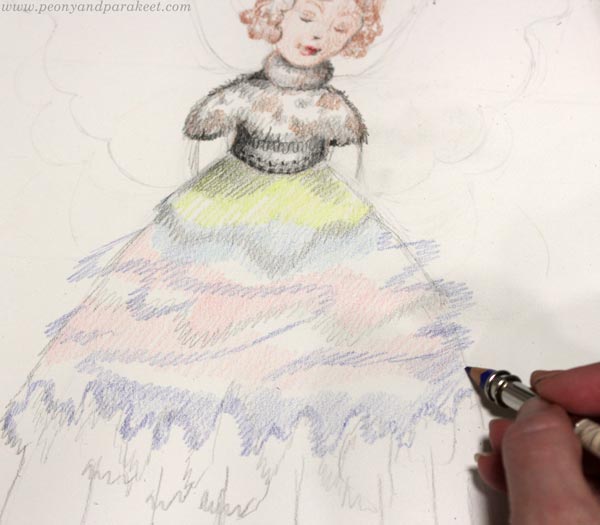
You can now use more colors but keep the coloring light and progress gradually layer by layer.
Step 4 – Add Details by Coloring
Go through the angel many times and add more details and shadows at every go.
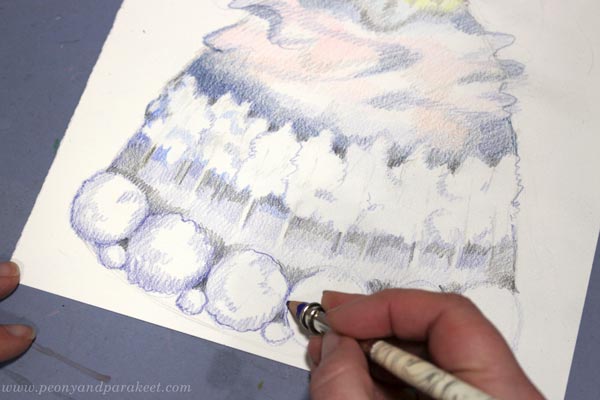
The more details you add, the more your imagination grows. For example, the wings can have decorative motifs.
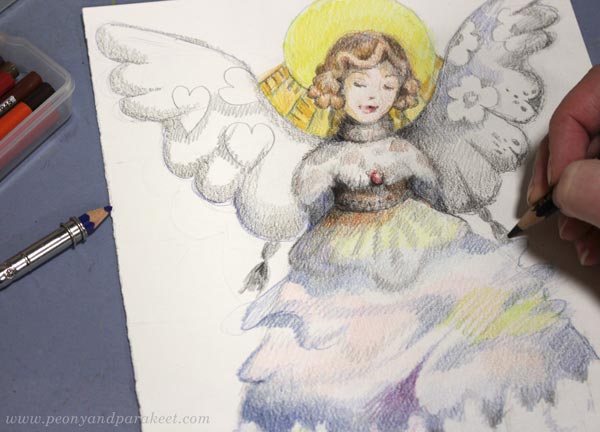
Make the angel more interesting by adding more asymmetry.
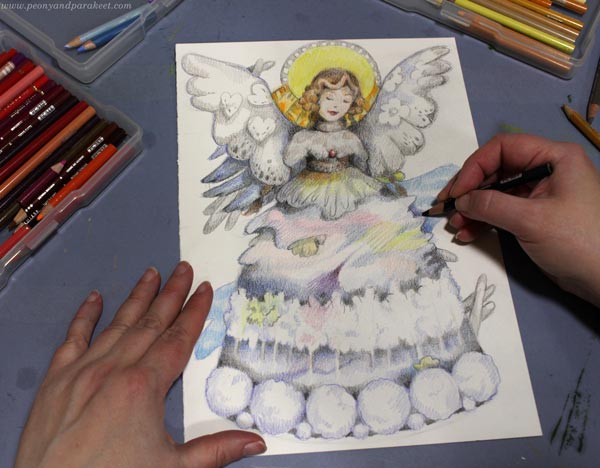
Draw elements like ice so that it’s placed differently on the two sides of the angel.
Step 5 – Cut Out and Finish
Cut the angel out of the paper and make final adjustments, especially near the cut-out edges. Now it’s also the time to make final adjustments to the facial features.
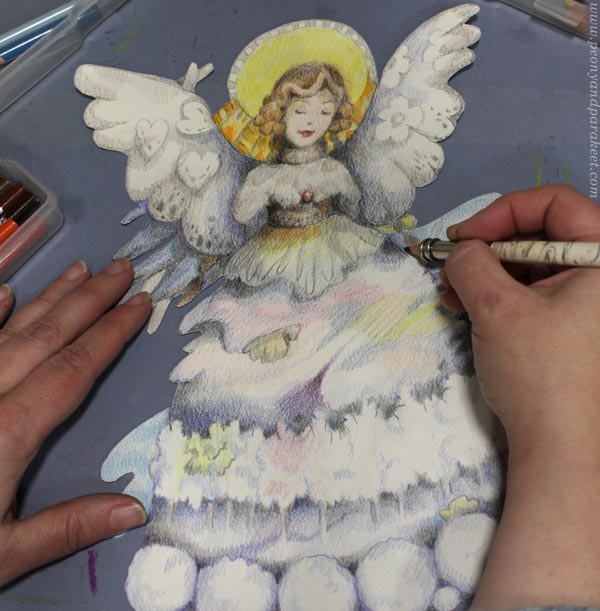
I added more decoration and cut a notch to the halo so that it’s like a glamorous hat.
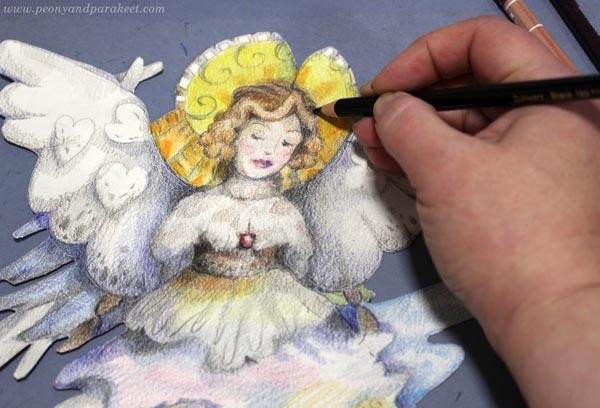
Step 6 – Play with the Winter Angel!
Combine other items with the doll, and enjoy making the settings! I like to pull out stuff from my boxes of hand-drawn elements – boxes of joy, as I call them!
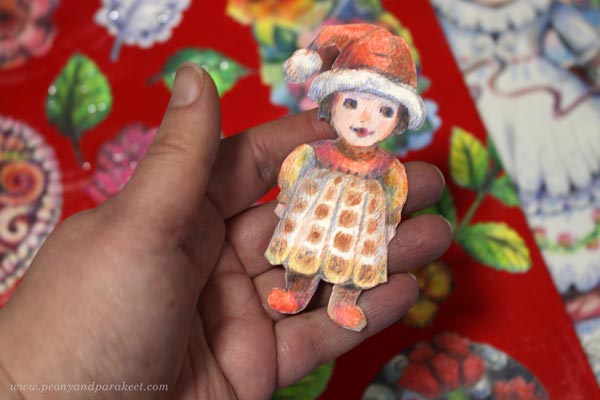
I drew this little Christmas Girl one evening when I was too tired to do anything else. I think it looks lovely with the winter angel!
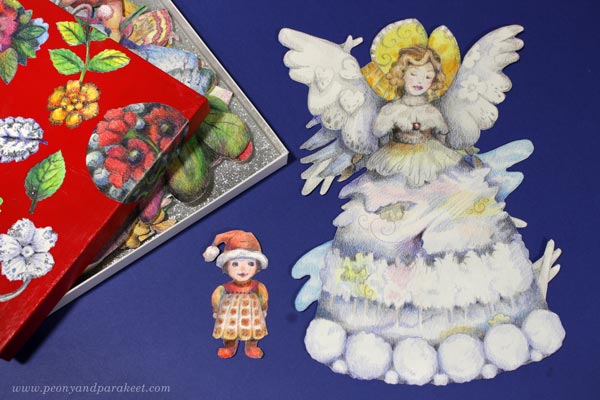
Doll World – Sign Up Now!
Come to draw more dolls and other beautiful items for your box of joy!
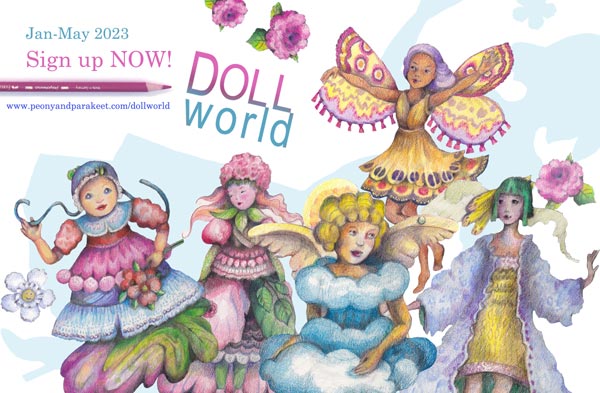
Doll World begins on January 1st, 2023. Watch the video and sign up here!